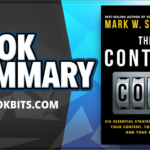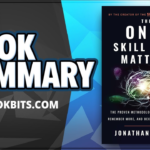GET THE 500+ BOOK SUMMARY BOX SET IN PDF & MP3 here
FOLLOW US HERE > |YouTube |Spotify | Instagram | Facebook | Newsletter | Website
Think, Learn, Succeed – Understanding and Using Your Mind to Thrive at School, the Workplace, and Life by Dr. Caroline Leaf
Think Learn Succeed contains valuable insights on mindsets and stresses how adopting an effective mindset can be the differentiating factor as to the levels of success and well-being that one attains in life. Furthermore, the book distills a great deal of neuroscientific research on the processes of learning as well as memory formation -helping readers to gain a better understanding of their own unique style of thinking.
The author, Dr. Caroline Leaf is a communication pathologist and cognitive neuroscientist, her research, for the last 30 years being mainly on the mind and body connection.
‘A thought is not just a thing, but rather, a thought is something that influences other things.’
- “We can choose to adopt a mindset that improves our creativity and functionality in general, or we can choose to adopt an attitude that constrains us.”
- Gratitude Mindset Activation: “Gratitude begins with an awareness of whether you have an attitude of gratitude, so intentionally and critically observe your thinking to determine if an attitude of gratitude is part of it.”
- Happiness Mindset Activation: “Be proactive in where you put your energy: you can choose to bemoan and marinate in your misery or move your energy to do something constructive.”
- “Emotions don’t happen to you; emotions are made by you, it is you who creates the tectonic nature of your emotional experience”
- Controlled Emotions Mindset Activation: The first step in controlling emotions is to recognize that you have control over your emotions. The second step is to realize that you are not responsible for the cause of the emotion but rather for the management of the emotion.
- “Re-conceptualize (redesign) thoughts that are holding you back by deciding what thought you would rather have and then work toward eliminating the toxic thought and building something better.”
- “You cannot control the events and circumstances of life. You can, however, control your reactions to the events and circumstances of life through the choices you make and the thoughts you think.”
- “Where your mind goes, your life follows.”
- “A mindset is an attitude or a cluster of thoughts with attached information and emotions that generate a particular perception. They shape how you see and interact with the world. They can catapult you forward, allowing you to achieve your dreams, or put you in reverse drive if you are not careful.”
- “And because you control your mindsets—they are not some pre-programmed function, but rather, it is you that is actually making your brain and body work for you.”
- “The ability to think, feel, and choose and build thoughts into mindsets is one of the most powerful things in the universe because this power is the source of all human creativity and imagination.”
- “Think of your mind as the movement of information as energy through your nervous system. Each thought has quantum energy and electrochemical and electromagnetic signals, which flow throughout your brain and body largely below the level of awareness in your non-conscious mind.”
- “Just thinking about a loved one, for example, can cause positive structural changes in the caudate nucleus of the brain, which is closely linked to feelings of reward and happiness. The converse also applies. Stress, which is actually good for you, can become incredibly toxic, depending on your perception of the situation.”
- “Essentially, the way you think, through the mindsets you adopt, will influence the neural correlates in your brain, thereby influencing your words and actions. In turn, these words and actions influence the brain, and a feedback loop is established based on this mindset.”
- An interesting study indicated that instead of trying to calm down when you experience pre-performance anxiety before a big event such as meeting with a boss, public speaking or writing a math exam, etc. re-conceptualizing the anxiety as excitement while taking deep slow breaths (which dissipates cortisol) helped people cope better.
[Note: this is in a sense, re-framing; instead of trying to calm your nerves before a performance, you tell yourself repeatedly ‘I’m excited!’]
- Thus, we can choose to adopt a mindset that harnesses our creativity and functionality in general, or we can choose to adopt an attitude that restricts us.
- “Where your mind goes, your life follows.”
- “Stem cells persist in the adult brain and generate new neurons throughout life; thousands of new cells are created on a daily basis. These thousands of new neurons that are added into the brain each day do not survive.”
- However, one of the most effective ways to keep these cells from dying (which increases toxic levels in your brain and body) is by thinking and learning properly.
- … process of reappraising and realigning your mindsets back to your natural wired-for-love design is integral to the life well-lived.
Dr. Leaf writes about genetic expression & mindfulness…
- She defines mindfulness as a way of deliberately and intentionally paying attention to what you think, say, and do in a self-reflective and self-regulatory way.
- “Your thinking, feeling, and choosing impacts your genetic expression. You switch genes on and off with every thought you have, and every thought you have is a response to the way you see and perceive your life experiences.”
- “…only about 5 percent of genetic mutations directly cause health issues.”
- “Approximately 95 percent of genes are influenced by life factors and lifestyle choices.”
- “By changing your thoughts, you change your mindsets, and in turn, you can influence and shape your own genetic readout. Research even shows that your mindsets can impact how you age.”
- “I did some of the first neuroplasticity research back in the eighties, showing how intentional, deliberate thinking changes intellectual, cognitive, emotional, social and academic performance.”
- “I emphasize retraining the brain as opposed to training the brain. It is incorrect to assume that the brain has a negative bias and that we have to fight off the brain’s natural tendency to scan for and spot the undesirable. This kind of negative mindset will actually work against the natural optimism bias of brain function and upset thinking patterns.”
- “What do you think about the most? Whatever you think about the most will grow; if you are thinking about something daily, within approximately two months your brain has changed to accommodate this pattern of thought.”
- “You plant these thoughts deep into your non-conscious mind, allowing them free rein to shape your mindset, which in turn affects your future thoughts, words, and actions.”
- “We merge with our environments; whatever we think about the most will have the most energy and will dominate our thinking, the good and the bad.”
- “Brain plasticity means the changes that occur in the brain as a result of thinking and lifestyle choices.”
- “Indeed, we can harness the brain’s plasticity by using our mind to train our brain to build normal positive patterns. This is called Automatization.”
- “Automatization is not incredibly difficult, but it does require time, discipline, and effort. If asked, I am certain you would be able to point out your positive and negative thinking habits, your love and fear mindsets.”
- “You have already been practicing building mindsets, albeit without consciously knowing the technique! The conscious control of this process can take you to a whole new level of life.”
THE THINKER MINDSET
- “The need to be constantly occupied does not just concern “kids these days.” One recent study found that being alone with one’s thoughts is considered an unpleasant experience by the majority of people of all ages.”
- “In a series of eleven studies done by Timothy Wilson and colleagues at the University of Virginia and Harvard, a number of the participants of all age ranges (18 to 77 years) battled spending 6 to 15 minutes alone with nothing to do but think, daydream, and ponder.”
- “The majority of the participants didn’t enjoy being alone with their thoughts, while some preferred even shocking themselves to sitting and thinking!”
- “The conclusions of this study indicate that most of the participants preferred to be doing something, even something negative, rather than just using their imagination for several minutes.”
- “Contrary to popular belief, the mind does not grind to a halt when you are doing nothing. Spontaneous thought processes, including mind-wandering, creative thinking, and daydreaming, arise when thoughts are relatively free from focused thinking and external influences.”
- “The mind-wandering ‘thinker’ state can be high-jacked, so to speak, by existing toxic thoughts moving up from our non-conscious mind unless we control them.”
- “Controlling the mind-wandering “thinker” is known as an awake resting state. It activates the coexisting default mode network (DMN) and task-positive network (TPN) in the brain in a constructive and healthy way.”
- “The default mode network(DMN) is a primary network that we switch into when we switch off from the outside world and move into a state of focused mindfulness. It activates to even higher levels when a person is daydreaming, introspecting, or letting his or her mind wander in an organized exploratory way through the endless myriad of thoughts within the deep spiritual non-conscious part of who we are.”
- “The task-positive network(TPN), on the other hand, supports the active thinking required for making decisions. So, as we focus our thinking and activate the DMN, at some point in our thinking process we move into active decision making. This activates the TPN, and we experience this as action.”
- It is your perceptions of your thoughts, and what you do with your thoughts, that is important.
- “Learning to capture thoughts and evaluate them logically by developing a thinker mindset is one of the most significant parts of any mental self-care regimen, allowing us to become more self-evaluative and self-regulatory.”
Thinker Mindset Activation Tips:
- “Thinker moments teach you how to live the self-examined life. As your mind wanders, think about what you are thinking and your own experiences, perhaps writing about your thoughts in a journal or notepad.”
- “During your thinker moments, write down, in a self-reflective way, which thoughts are free-flowing as well as which thoughts get stuck. Track the direction of free-flowing thoughts over time. Capture and change the thoughts that get stuck.”
- “The average person spends up to eight hours a day using technology. Some of the worst effects of electronic devices seem to be mitigated when devices are used less than two hours a day. Find ways to limit your use of technology throughout the day.”
THE CONTROLLED THINKING MINDSET
- “It is possible, however, to learn about your mental processes by thinking about your thinking and choosing what to think about. This process of self-reflection is not only possible but essential.”
- “Mind-body research increasingly points to the fact that consciously controlling your thoughts is one of the best ways, if not the best way, of detoxing your brain and body.”
- “Consciously controlling your thought life means that you do not allow thoughts to rampage through your mind. Instead, you learn to engage interactively with each thought, taking control over and learning to enjoy the moment you are in. Essentially, your job is to analyze a thought before you decide either to accept or reject it.”
Controlled Thinking Mindset Activation Tips:
- “Never let thoughts just wander through your mind unchecked. Focus on the now moment and observe your thoughts and feelings.”
- “Re-conceptualize (redesign) thoughts that are holding you back by deciding what thought you would rather have and then work toward eliminating the toxic thought and building something better. Here is an example:
Start with acknowledging and articulating thoughts weighing you down—ones that don’t serve any useful purpose beyond keeping you stuck. Now ask yourself questions rather than issuing commands to yourself—this is a much more effective way to re-conceptualize because it opens up exploration, creates possibility, and distances you from what you are thinking, giving you a safe space for change. You can also label your emotions in a nonjudgmental way to give yourself some distance from them in order to deal with them.”
THE WORDS MINDSET
- “When you make negative statements, you release negative chemicals. These chemicals allow negative memories to grow stronger, especially if you continue to allow these thoughts to dominate your thinking. On the other hand, the more you speak positively, the more you think positively!”
- “Please note, I am talking about much more than just positive thinking or positive affirmations because framing your world with words is not just about talking positively.”
- “The problem with positive affirmations, per se, is that they operate at the surface level of conscious thinking but do not align with the non-conscious mind where limiting beliefs really reside.”
- “Your words have to be backed up with honesty and integrity, or what in psychological terms is called cognitive congruence. What you do and say on the outside must reflect what you think and actually believe on the inside.”
- “Being more intentionally mindful about what you want to say, what you are saying, and what you are actually thinking about what you are saying bring all sorts of prefrontal resources to help get the amygdala unstuck from toxic emotions.”
- “This happens because the more intentionally mindful you are, the more activation you have in the right ventrolateral prefrontal cortex and the less activation you have in the amygdala in response—and this is a good thing.”
- “Thus, congruent thinking, not positive words, creates the necessary changes in the brain. This type of thinking takes time and effort because you have to be aware of your words and the mindset behind them.”
Words Mindset Activation Tips:
- “Start replacing negative statements with positive ones, thinking about the kind of change you want to see in your life. You might re-conceptualize your self-talk to sound more like “I am a work in progress, and that’s totally fine.” ”
- “Putting feelings into words has tremendous therapeutic effects on your mind and brain.”
THE CONTROLLED EMOTIONS MINDSET
- “Emotions don’t happen to you; emotions are made by you.”
- “When you repress and deny your emotions, whatever they may be, you block the network of quantum and chemical pathways, stopping the flow of good chemicals that run your biology and behavior.”
- “Unfortunately, many of us have become experts at hiding our emotions—or think we have. Instead, we create neurochemical chaos in our brains. Signs of suppressed feelings arising from this conflict include irritability, short temper, over-reactivity, anxiety, frustration, fear, impulsiveness, a desire for control, perfectionism, and self-doubt.”
- “You are not at the mercy of preprogrammed emotion circuits that neurocentric approaches are dangerously trying to convince you of. This does not mean you deserve blame for your emotions; it means you need to take responsibility for how you are going to manage them so they don’t carry into your future with negative effects.”
Controlled Emotions Mindset Activation Tips:
- “The first vital step in controlling emotions is recognizing you have control over your emotions! You build them into your brain in a creative choice with your mind. They are not universal or preprogrammed; they are unique to you.”
- “The second vital step is to recognize you are not responsible for the cause of the emotion but rather for the management of the emotion.”
- “You do not have to wear your heart on your sleeve or let everything hang out. But you do have to be honest with yourself. Working out what you are feeling and how to deal with these emotions is an evolving process.”
- “Do not deny your feelings. Acknowledge them, face them, deal with them, and name them in a positive way as soon as possible—but most importantly, when you are ready.”
THE FORGIVENESS MINDSET
- “Forgiveness does not deny pain or wrongdoing; it is a choice to let go of the person who hurt you.”
- “Forgiveness does not make excuses for someone’s behavior. By its nature, forgiveness acknowledges wrongdoing, and, at the same time, you choose to show grace and mercy.”
- “We’re often told to “forgive and forget” the wrongs that we suffer, but it turns out that there is scientific truth behind the common saying.”
- “Forgiveness changes the brain. Research shows that forgiving someone increases the size of the brain’s anterior superior temporal sulcus (aSTS). In fact, the larger the amount of grey matter in this patch of cortex, the more likely we are to forgive those who have made a serious mistake by accident.”
- Also, the more you forgive, the more you are likely to forgive—the brain changes to accommodate a forgiveness mindset.
Forgiveness Mindset Activation Tips:
- Re-conceptualize the memory. Find a new way to think about the person(s) who hurt you. Think about the context. What was happening in that person’s life when the hurt occurred? Why did they perhaps do what they did? What is their story? What is your story? Where are you in life?
- Acknowledge the issue and the attached pain and anger you feel. You have to be honest with yourself if you truly want to forgive someone.
- Recognize that healing requires time.
THE HAPPINESS MINDSET
- “Scrolling through instagram, it is easy to believe that happiness means having a lot of money, nice things, status, or privilege.”
- Happiness has more to do with a sense of inner satisfaction than external consumption. Happiness is knowing where you belong and knowing why you are alive, regardless of your circumstances.
- “I cannot emphasize enough the importance of the link between happiness and community. Berkeley neuroscientist Emiliana Simon-Thomas has found that people with the strongest social connections are the happiest.”
- “We also need to remember that happiness precedes success. Working harder and achieving some entrepreneurial or academic or personal goal will not automatically make you happier.”
- Our happiness does not depend on our circumstances. Furthermore, happiness also does not mean a smooth and uncomplicated life, if such a life even exists.
- “The brain works significantly better when you choose to feel happy in the midst of a challenge. I have found repeatedly in my research and clinical experience and personal life that excitement arises when we adopt a positive attitude and persist in the face of a daunting task.”
Happiness Mindset Activation Tips:
- “Be proactive in where you put your energy: you can choose to bemoan and marinate in your misery or move your energy to do something constructive.”
- “Don’t allow yourself to think that I will be so happy when this is over. Enjoy the start, the middle, and the end! Tell yourself it is okay to experience different emotions, moving toward peaceful acceptance.”
THE GRATITUDE MINDSET
- “One recent study investigated the effects of gratitude on Behavior and looked at the response in the brain to the mind.1 The researchers found that subjects who participated in a gratitude letter-writing exercise showed both positive changes in their behavior and greater brain activity in the front of the brain (medial prefrontal cortex) up to three months later.”
- “When we choose to be grateful, we tap into our natural design. Research on the effects gratitude has on our biology shows how being thankful increases our longevity, our ability to use our imagination, and our ability to problem-solve. It also improves our overall health.”
Gratitude Mindset Activation Tips:
- “Gratitude begins with an awareness of whether you have an attitude of gratitude, so intentionally and critically observe your thinking to determine if an attitude of gratitude is part of it.”
- “Are you thankful? Spend the next week analyzing how grateful you are. Keep a record, somehow, of every time you are grateful and every time you are whiny over a seven-day period. Tally it up at the end of the seven days—you may be shocked at the results!”
THE GIFT PROFILE
- The GIFT Profile is a tool that one can use to understand the way that they learn and process information.
- In her book ‘Think Learn Succeed,’ Caroline Leaf explains in great detail the research methodology she used to develop the profile as well as how to utilize this model of learning. She provides a questionnaire that readers can complete to get their own customized Gift analysis and gain a better understanding of their own thinking.
She further clarifies:
- “Each one of us has seven stages that our thoughts sequence through in order to digest information. This sequence is called the cycle of thinking. Our uniqueness comes in which module of thought we use for which stage of the cycle. The process is different for each of us.”
- “For example, one person may use Intrapersonal for stage one, and another person may use Kinesthetic for stage one. However, until we move through all of these seven stages—each in our own way—the thought will not be fully processed. In other words, we won’t be thinking properly unless we move through all seven stages of the thinking cycle.”
THE SWITCH ON YOUR BRAIN 5-STEP LEARNING PROCESS
- “It has been collectively demonstrated that just about every aspect of our thinking, learning, and intelligence—our brainpower—can be improved by intense, targeted, deliberate mind training. The Switch on Your Brain 5-Step Learning Process provides a technique for this kind of organized drive.”
- “The model is made up of 5 steps that facilitate this disciplined and directed learning process. Each step is designed to take you beyond short-term memory and into building effective and useful long-term memory. Each step is also designed to take advantage of a particular brain process, with all steps collectively moving toward the goal of memory building and learning.”
The five steps are:
- Input: read, listen, watch
- Reflect: ask, answer, discuss
- Write: create the Metacog
- Recheck: check for accuracy
- Output: re-teach
- “The Golden Rule of the Switch on Your Brain 5-Step Learning Process is to think to understand the information you are trying to remember. Thinking to understand involves three steps: asking, answering, and discussing.
Dr. Caroline Leaf elaborates:
- Read a chunk of information—between one to three sentences—out loud, with your guide (pencil, pointer, or finger).
- Stop and ask yourself what you have read.
- Now, answer yourself by looking at what you have just read. Then answer yourself by rereading the chunk of information out loud and circling the concepts. Don’t underline or highlight words. Those are passive actions because they don’t require you to think, analyze, or understand what you have underlined or highlighted. Circling is active.
Next, discuss this chunk of information with yourself, still looking at the sentence(s) you have just read. Discussion means you explain it to yourself over and over in your own words until you understand.”
EPILOGUE
- “You cannot control the events and circumstances of life. You can, however, control your reactions to the events and circumstances of life through the choices you make and the thoughts you think.”
- “When you understand the power of your mindsets and your customized way of thinking and harness the power in your mind to build healthy memories, you will begin to realize that you can choose to control how you live your life.”













